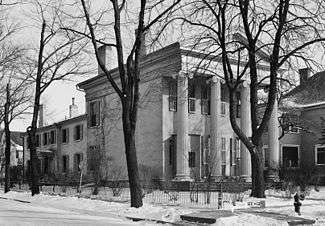Judge Robert S. Wilson House
|
Judge Robert S. Wilson House | |
|
| |
  | |
| Location | 126 N. Division St., Ann Arbor, Michigan |
|---|---|
| Coordinates | 42°16′55″N 83°44′37″W / 42.28194°N 83.74361°WCoordinates: 42°16′55″N 83°44′37″W / 42.28194°N 83.74361°W |
| Area | less than one acre |
| Built | 1839 |
| Architectural style | Greek Revival |
| NRHP reference # | 72000663[1] |
| Added to NRHP | March 16, 1972 |
The Judge Robert S. Wilson House, also known as the Wilson-Wahr House,[2] is a private house located at 126 North Division Street in Ann Arbor, Michigan. It was listed on the National Register of Historic Places in 1972.[1]
History
Robert S. Wilson was an attorney who moved from Allegheny County, New York, to Ann Arbor in 1835.[3] He was Judge of the Washtenaw County Probate court for a year, and served in the Michigan House of Representatives. In approximately 1839, Wilson had this house built on a lot in Ann Arbor. He lived there until 1850, when he moved to Chicago[3] and sold the house to John H. Welles.[4]
Welles is thought to have constructed the rear addition to the house, and made other extensive alterations.[4] In 1855, his son Henry moved into the house with his four daughters.[2] Henry Welles died in 1860, and the house passed to successive owners.[2] In 1893, the house was sold to in a tax sale to George Wahr. The Wahr family constructed another house next door as their residence, and rented the house to sororities and fraternities.[5] After 20 years, they moved back into the main Wilson-Wahr House.[6] The house passed on to the Wahr's daughter, Natalie Wahr Sallade, and the Sallades occupied the house until recently.
Architecture
The Robert S. Wilson House is a two-story Greek Revival structure constructed of brick with a stucco finish on a stone foundation.[3] Nearly every survey of Michigan architecture has singled out the Wilson House as an outstanding specimen of Neoclassical architecture design.[3]
The front facade boasts a full-width portico with Ionic fluted shaft columns, and an entryway framed by matching pilasters. Windows have external shutters. A two-story addition on the rear was likely constructed more recently than the main portion of the house.[3]
- Interior
Inside, the main section of the house is two parlors deep with a hall containing a stairwell to the side. The rear addition has a side entrance into another stair hall. All the major rooms in the house have fireplaces.[3]
See also
- National Register of Historic Places listings in Washtenaw County, Michigan
- Buildings and structures in Ann Arbor, Michigan
References
- Kimball, Fiske (1922). Domestic Architecture of the American Colonies and of the Early Republic. New York: Charles Scribner's Sons. LCCN 22024675.
Notes
- 1 2 National Park Service (2010-07-09). "National Register Information System". National Register of Historic Places. National Park Service.
- 1 2 3 Maldonado, Yvo. "Wilson-Wahr House". Retrieved June 16, 2013.
- 1 2 3 4 5 6 "Judge Wilson House". Michigan State Housing Development Authority: Historic Sites Online. Archived from the original on March 1, 2014. Retrieved March 13, 2013.
- 1 2 Wenzell, Herbert G. (1936). "Judge R. S. Wilson House" (PDF). Historic American Building Survey. Washington, D.C.: Library of Congress. Archived from the original (PDF) on March 3, 2014. Retrieved February 25, 2014.
- ↑ "126 North Division Street". Ann Arbor District Library. Archived from the original on December 7, 2013. Retrieved June 16, 2013.
- ↑ Arlinghaus, Sandra Lach. "Division Street Historic District". Retrieved June 16, 2013.

External links
| Wikimedia Commons has media related to Wilson House (Ann Arbor). |
- Historic American Buildings Survey (HABS) No. MI-27-2, "Judge R. S. Wilson House, East Ann & North Division Streets, Ann Arbor, Washtenaw County, MI", 3 photos, 9 measured drawings, 3 data pages
- History of Judge Wilson House
